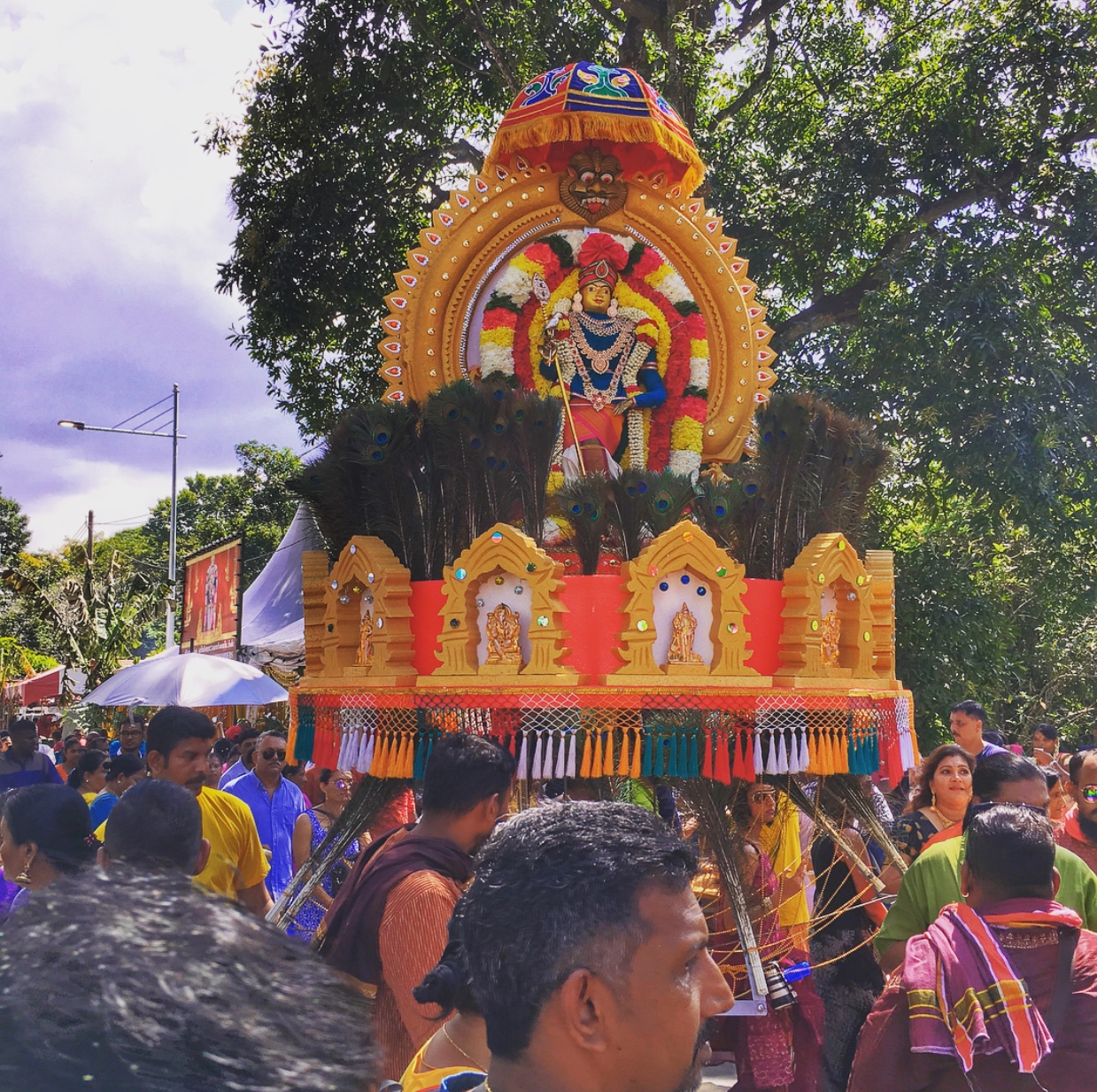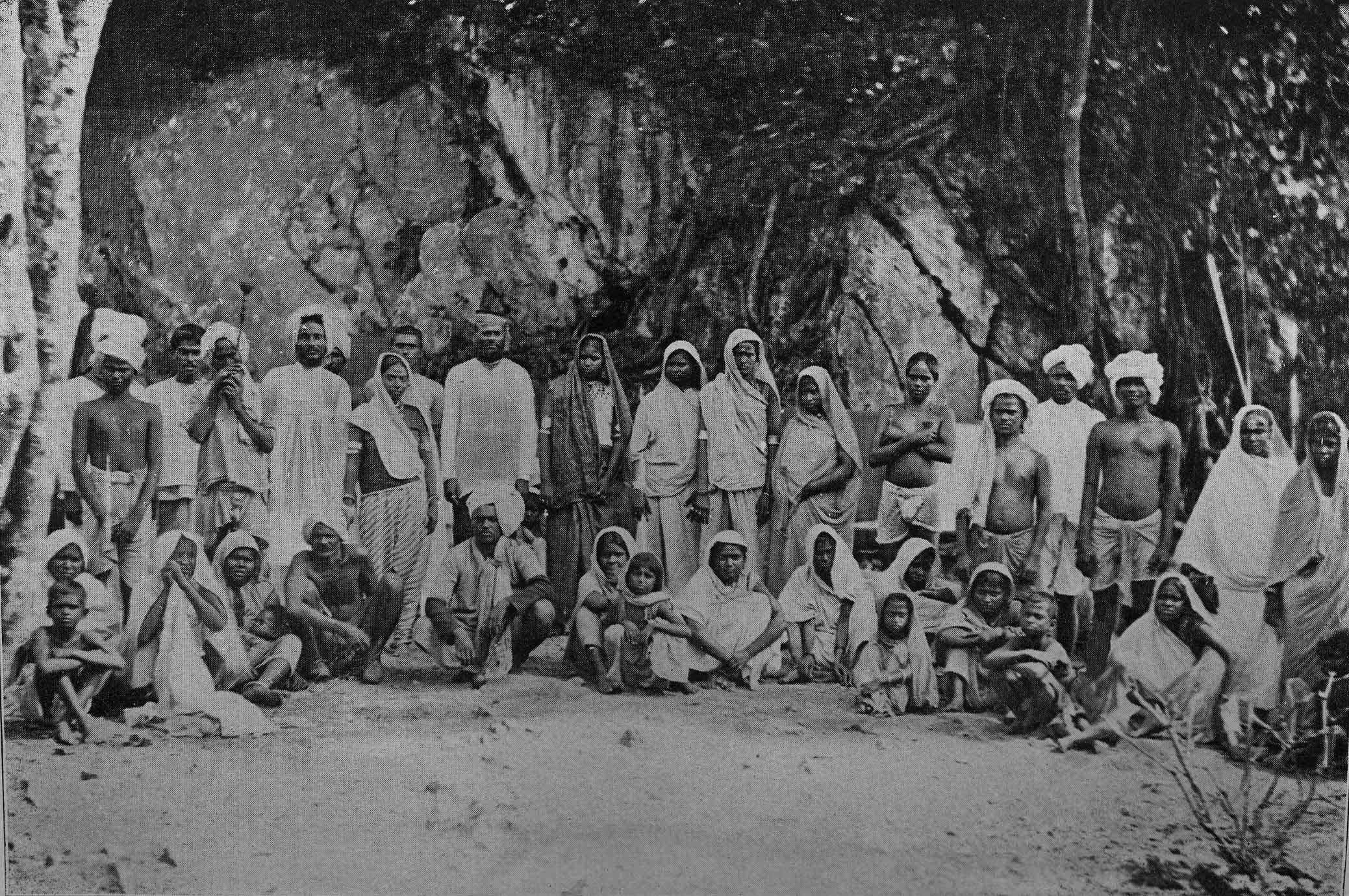|
Tamil South Africans
Tamil South Africans are Indian South Africans of Tamil descent. Tamil people form the majority of Indian immigrants who came from India to Natal, South Africa, from 1860 onwards. After the expiry of their indentures most of these Indians moved to the cities, becoming established as a thoroughly urban population. Arrival in South Africa During the Dutch colonial period, people from parts of India and Sri Lanka were sent to the Cape as slaves. In the early 18th century, about half of the slaves in the Cape were from India and Sri Lanka. In 1677, 93 indentured people from Thootukudi (a coastal town in the southern state of Tamil Nadu) were made to go the Cape while in 1712, 36 indentured people from Sri Lanka were made to do to South Africa by the Dutch/British oppressors and 80 in 1719. There was another shipment from Sri Lanka in 1754 with an intermediate number of indentured people. In 1833, the British Parliament passed the Act of Abolition, which banned slavery throughout th ... [...More Info...] [...Related Items...] OR: [Wikipedia] [Google] [Baidu] |
KwaZulu-Natal
KwaZulu-Natal (, also referred to as KZN and known as "the garden province") is a province of South Africa that was created in 1994 when the Zulu bantustan of KwaZulu ("Place of the Zulu" in Zulu) and Natal Province were merged. It is located in the southeast of the country, with a long shoreline on the Indian Ocean and sharing borders with three other provinces and the countries of Mozambique, Eswatini and Lesotho. Its capital is Pietermaritzburg, and its largest city is Durban. It is the second-most populous province in South Africa, with slightly fewer residents than Gauteng. Two areas in KwaZulu-Natal have been declared UNESCO World Heritage Sites: the iSimangaliso Wetland Park and the uKhahlamba Drakensberg Park. These areas are extremely scenic as well as important to the surrounding ecosystems. During the 1830s and early 1840s, the northern part of what is now KwaZulu-Natal was established as the Zulu Kingdom while the southern part was, briefly, the Boer ... [...More Info...] [...Related Items...] OR: [Wikipedia] [Google] [Baidu] |
Dravidian People
The Dravidian peoples, or Dravidians, are an ethnolinguistic and cultural group living in South Asia who predominantly speak any of the Dravidian languages. There are around 250 million native speakers of Dravidian languages. Dravidian speakers form the majority of the population of South India and are natively found in India, Pakistan, Afghanistan, Bangladesh, the Maldives, Nepal, Bhutan and Sri Lanka. Dravidian peoples are also present in Singapore, Malaysia, South Africa, Myanmar, East Africa, the Caribbean, and the United Arab Emirates through recent migration. Proto-Dravidian may have been spoken in the Indus civilization, suggesting a "tentative date of Proto-Dravidian around the early part of the third millennium", after which it branched into various Dravidian languages. with whom they intensively interacted. Genetically, the ancient Indus Valley people were composed of an Iranian hunter gatherers-related and an Ancient Ancestral South Indian (AASI) component, whil ... [...More Info...] [...Related Items...] OR: [Wikipedia] [Google] [Baidu] |
Thai Poosam Kavady Festival In South Africa
Thai Poosam Kavady is a Tamil religious festival dedicated to Hindu god Lord Murugan that is celebrated by Tamil people in South Africa. Symbolism Kavady translates in Tamil language as a pole slung across the shoulder to evenly distribute the weight of whatever is being carried, usually in bundles on either ends of the pole. The carrying of kavady symbolizes the carrying of one's burden and then resting it at the feet of the Lord. See also * Thaipusam Thaipusam or Thaipoosam (Tamil: தைப்பூசம், ''taippūcam'' ?), is a festival celebrated by the Hindu Tamil community on the full moon in the Tamil month of ''Thai'' (January/February), usually coinciding with Pushya star, kn ... References Hindu festivals Religious festivals in South Africa Culture of Indian diaspora Tamil festivals {{reli-festival-stub ... [...More Info...] [...Related Items...] OR: [Wikipedia] [Google] [Baidu] |
Thaipusam
Thaipusam or Thaipoosam (Tamil language, Tamil: தைப்பூசம், ''taippūcam'' Wikipedia:Naming conventions (Indic), ?), is a festival celebrated by the Hindu Tamil people, Tamil community on the full moon in the Tamil calendar, Tamil month of ''Thai'' (January/February), usually coinciding with Pushya star, known as Poosam in Tamil language, Tamil. The festival is also observed among Hindu Keralites and is vernacularly called Thaipooyam (Malayalam: തൈപ്പൂയം). It is mainly observed in countries where there is a significant presence of Tamil community such as India, Sri Lanka, Malaysia, Mauritius, as well as other places where ethnic Tamil people, Tamils reside as a part of the local Non-Resident Indian and Person of Indian Origin, Indian diaspora population such as Canada, Singapore, South Africa, the United States, Réunion, Indonesia, Thailand, Myanmar, Trinidad and Tobago, Guyana, Suriname, Jamaica and the other parts of the Caribbean. It is a n ... [...More Info...] [...Related Items...] OR: [Wikipedia] [Google] [Baidu] |
Kavadi Aattam
Kavadi Aattam ( Tamil: காவடி ஆட்டம், Malayalam: കാവടിയാട്ടം) ("Burden Dance") is a ceremonial sacrifice and offering practiced by devotees during the worship of Murugan,Kent, Alexandra. ''Divinity and Diversity: A Hindu Revitalization Movement in Malaysia''. University of Hawaii Press, 2005. () the Hindu god of war. It is a central part of the festival of Thaipusam and emphasizes debt bondage. The ''kavadi'' ("burden") itself is a physical burden, the bearing of which is used by the devotee to implore Murugan for assistance, usually on behalf of a loved one who is in need of healing, or as a means of balancing a spiritual debt.Hume, Lynne. ''Portals''. Devotees process and dance along a pilgrimage route while bearing these burdens. Legend The myth behind the practice of the ''kavadi aattam'' is steeped in Tamil mythology. At Mount Kailash, Shiva is said to have entrusted the sage Agastya with two hillocks, the Shivagiri hill, and t ... [...More Info...] [...Related Items...] OR: [Wikipedia] [Google] [Baidu] |
Vishnu
Vishnu ( ; , ), also known as Narayana and Hari, is one of the principal deities of Hinduism. He is the supreme being within Vaishnavism, one of the major traditions within contemporary Hinduism. Vishnu is known as "The Preserver" within the Trimurti, the triple deity of supreme divinity that includes Brahma and Shiva. Gavin Flood, An Introduction to Hinduism' (1996), p. 17. In Vaishnavism, Vishnu is the supreme being who creates, protects, and transforms the universe. In the Shaktism tradition, the Goddess, or Adi Shakti, is described as the supreme Para Brahman, yet Vishnu is revered along with Shiva and Brahma. Tridevi is stated to be the energy and creative power ( Shakti) of each, with Lakshmi being the equal complementary partner of Vishnu. He is one of the five equivalent deities in Panchayatana puja of the Smarta tradition of Hinduism. According to Vaishnavism, the highest form of Ishvara is with qualities ( Saguna), and have certain form, but is li ... [...More Info...] [...Related Items...] OR: [Wikipedia] [Google] [Baidu] |
Cape Coloureds
Cape Coloureds () are a South African ethnic group consisted primarily of persons of mixed race and Khoisan descent. Although Coloureds form a minority group within South Africa, they are the predominant population group in the Western Cape. They are generally bilingual, speaking Afrikaans and English, though some speak only one of these. Some Cape Coloureds may code switch, speaking a patois of Afrikaans and English called also known as Cape Slang (Capy) or , meaning Kitchen Afrikaans. Cape Coloureds were classified under apartheid as a subset of the larger Coloured race group. At least one genetic study indicates that Cape Coloureds have an ancestry consisting of the following ethnic groups: * Khoisan: (32–43%) * Bantu-speaking Africans: (20–36%) * Ethnic groups in Europe: (21–28%) * Asian peoples: (9–11%) Origin and history The Cape Coloureds are a heterogeneous South African ethnic group, with diverse ancestral links. Ancestry may include European settlers, ... [...More Info...] [...Related Items...] OR: [Wikipedia] [Google] [Baidu] |
Christianity
Christianity is an Abrahamic monotheistic religion based on the life and teachings of Jesus of Nazareth. It is the world's largest and most widespread religion with roughly 2.38 billion followers representing one-third of the global population. Its adherents, known as Christians, are estimated to make up a majority of the population in 157 countries and territories, and believe that Jesus is the Son of God, whose coming as the messiah was prophesied in the Hebrew Bible (called the Old Testament in Christianity) and chronicled in the New Testament. Christianity began as a Second Temple Judaic sect in the 1st century Hellenistic Judaism in the Roman province of Judea. Jesus' apostles and their followers spread around the Levant, Europe, Anatolia, Mesopotamia, the South Caucasus, Ancient Carthage, Egypt, and Ethiopia, despite significant initial persecution. It soon attracted gentile God-fearers, which led to a departure from Jewish customs, and, after t ... [...More Info...] [...Related Items...] OR: [Wikipedia] [Google] [Baidu] |
Apartheid
Apartheid (, especially South African English: , ; , "aparthood") was a system of institutionalised racial segregation that existed in South Africa and South West Africa (now Namibia) from 1948 to the early 1990s. Apartheid was characterised by an authoritarian political culture based on ''baasskap'' (boss-hood or boss-ship), which ensured that South Africa was dominated politically, socially, and economically by the nation's Minoritarianism, minority White South Africans, white population. According to this system of social stratification, white citizens had the highest status, followed by Indian South Africans, Indians and Coloureds, then black Africans. The economic legacy and social effects of apartheid continue to the present day. Broadly speaking, apartheid was delineated into ''petty apartheid'', which entailed the segregation of public facilities and social events, and ''grand apartheid'', which dictated housing and employment opportunities by race. The f ... [...More Info...] [...Related Items...] OR: [Wikipedia] [Google] [Baidu] |
Indian Indenture System
The Indian indenture system was a system of indentured servitude, by which more than one million Indians were transported to labour in European colonies, as a substitute for slave labor, following the abolition of the trade in the early 19th century. The system expanded after the abolition of slavery in the British Empire in 1833, in the French colonies in 1848, and in the Dutch Empire in 1863. British Indian indentureship lasted till the 1920s. This resulted in the development of a large Indian diaspora in the Caribbean, Natal (South Africa), East Africa, Réunion, Mauritius, Sri Lanka, Malaysia, Myanmar, British Guyana, to Fiji, as well as the growth of Indo-Caribbean, Indo-African, Indo-Fijian, Indo-Malaysian, Indo-Guyanese and Indo-Singaporean populations. First indenture On 18 January 1826, the Government of the French Indian Ocean island of Réunion laid down terms for the introduction of Indian labourers to the colony. Each man was required to appear bef ... [...More Info...] [...Related Items...] OR: [Wikipedia] [Google] [Baidu] |
Colony Of Natal
The Colony of Natal was a British colony in south-eastern Africa. It was proclaimed a British colony on 4 May 1843 after the British government had annexed the Boer Natalia Republic, Republic of Natalia, and on 31 May 1910 combined with three other colonies to form the Union of South Africa, as one of its Natal Province, provinces. It is now the KwaZulu-Natal province of South Africa. It was originally only about half the size of the present province, with the north-eastern boundaries being formed by the Tugela River, Tugela and Buffalo River (KwaZulu-Natal), Buffalo rivers beyond which lay the independent Kingdom of Zulu Kingdom, Zululand (''kwaZulu'' in the Zulu language). Fierce conflict with the Zulu people, Zulu population led to the evacuation of Durban, and eventually, the Boers accepted British annexation in 1844 under military pressure. A British governor was appointed to the region and many settlers emigrated from Europe and the Cape Colony. The British established a ... [...More Info...] [...Related Items...] OR: [Wikipedia] [Google] [Baidu] |





